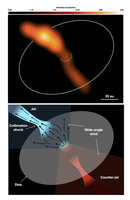Jet Origin in a Massive Protostar
 Protostellar jets have a fundamental role at the earliest evolution of protostars of all masses. In the case of low-mass (< 8M⊙) protostars, strong observational evidence exists that the launching and collimation is due to the X- and/or disk-wind mechanisms. In these models, it is the protostar/disk system that creates all the necessary conditions to launch and collimate the jets near the protostar via strong magnetic fields. The origin of jets from more massive protostars has been investigated much less, in part because of the difficulty of resolving the collimation zone in these more distant objects. Here, the authors present the highest angular resolution observations of a jet powered by a massive protostar, the Cep A HW2 radio jet. The radio emission was imaged at projected distances of only ~20 AU from the protostar, resolving the innermost 100 AU of a massive protostellar jet for the first time. The morphology of the radio jet emission in this massive object is very different than what is usually observed in jets from low-mass protostars. The authors found that the outflowing material in HW2 has two components: a wide-angle wind launched from the protostar/disk system, and a highly collimated jet starting at 20-30 AU from the protostar. Two possible scenarios are discussed: an extension of the classical disk-wind to a massive protostar, or external collimation of a wide-angle wind. These results have important consequences for understanding how stars of different masses are formed.
Protostellar jets have a fundamental role at the earliest evolution of protostars of all masses. In the case of low-mass (< 8M⊙) protostars, strong observational evidence exists that the launching and collimation is due to the X- and/or disk-wind mechanisms. In these models, it is the protostar/disk system that creates all the necessary conditions to launch and collimate the jets near the protostar via strong magnetic fields. The origin of jets from more massive protostars has been investigated much less, in part because of the difficulty of resolving the collimation zone in these more distant objects. Here, the authors present the highest angular resolution observations of a jet powered by a massive protostar, the Cep A HW2 radio jet. The radio emission was imaged at projected distances of only ~20 AU from the protostar, resolving the innermost 100 AU of a massive protostellar jet for the first time. The morphology of the radio jet emission in this massive object is very different than what is usually observed in jets from low-mass protostars. The authors found that the outflowing material in HW2 has two components: a wide-angle wind launched from the protostar/disk system, and a highly collimated jet starting at 20-30 AU from the protostar. Two possible scenarios are discussed: an extension of the classical disk-wind to a massive protostar, or external collimation of a wide-angle wind. These results have important consequences for understanding how stars of different masses are formed.
Image Caption: (Above) VLA 40 GHz image of the jets in the massive protostar, Cep A HW2, at 40 milli-arcsec resolution. (Below) The model for the conical wind and the narrow jet.
Publication: Carlos Carrasco-Gonzales ( Instituto de Radioastronoḿıa y Astrofısica, IRyA-UNAM) et al., Zooming into the Collimation Zone in a Massive Protostellar Jet, Astrophysical Journal Letters, 914, L1 (June 2021).
NRAO Press Release: Jets from Massive Protostars Might be Very Different from Lower-Mass Systems, Astronomers Find




Connect with NRAO